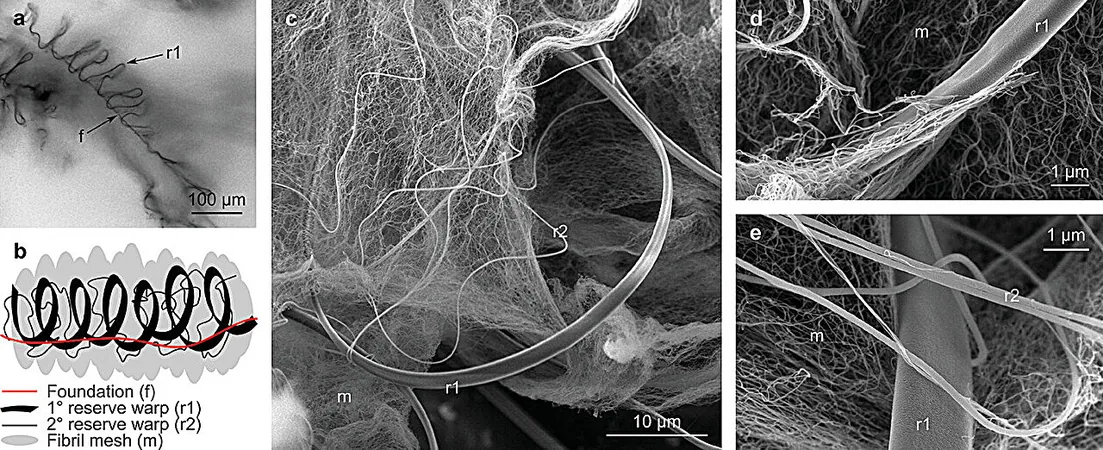
Revolutionary Study Unveils the Incredible Strength of Spider Silk Nanofibrils
2024-10-30
Author: Jia
In a groundbreaking breakthrough, researchers at the College of William & Mary have successfully measured the strength and flexibility of spider silk nanofibrils—tiny structures just a few molecular layers thick, roughly one ten-thousandth the diameter of a human hair. These fascinating fibers are invisible to the naked eye and can only be seen with advanced microscopy techniques.
Jake Silliman, a doctoral candidate in applied science, has accomplished what many considered nearly impossible. His advisor, VMEC Professor Hannes Schniepp, a well-known researcher in the field of spider silk for nearly 15 years, hailed Silliman's success, stating, “Other people have tried. Most gave up, but Jake didn’t, and he succeeded. It’s actually kind of crazy to think that it’s even possible.”
These exciting findings, published in the highly esteemed journal *Advanced Functional Materials*, underline the innovative spirit of William & Mary’s new School of Computing, Data Sciences & Physics. The partnership between Silliman and Schniepp exemplifies the university’s commitment to providing personalized education and mentorship to its students.
“One of my long-term goals is to develop new materials inspired by nature,” said Schniepp. “We humans often believe we are the pinnacle of invention, but nature offers endless inspiration for exciting innovations.”
Spider silk is approximately five times stronger than steel by weight, but even more remarkable is its unique combination of strength and elasticity, enabling it to absorb massive amounts of energy. If scientists can replicate the structure of spider silk, it could lead to a future where super-strong, lightweight materials are used in everything from bungee cords to protective shields for high-impact environments.
Schniepp explained the complexity of spider silk, which is formed from the elaborate structures produced by various spider species—about 50,000 in total. For this study, the researchers focused on silk from the southern house spider, which features a distinctive nanofibril mesh.
The spinning mechanism of this spider comprises hundreds of nozzles that weave together a sophisticated three-dimensional strand. This entails a core structure where two distinct warps create helical loops around a central fiber, with the minute nanofibrils forming a supportive mesh around them.
Silliman utilized atomic force microscopy (AFM) to analyze the strength and stretchability of these nanofibrils. This highly specialized technique allows for observation and measurement of extremely small objects. He meticulously transferred nanofibrils from the spider silk onto a miniature silicon disk, equipped with around two million holes—each measuring just 200 nanometers in diameter.
“Essentially, we employ a needle that's astonishingly small—only a few nanometers at its end—and tap it across the sample,” Silliman explained. “This builds a topographic map pixel by pixel.” The AFM needle is so precise that its tip is merely a few atoms thick, far beyond the resolution of standard optical microscopes.
Due to potential vibrational interference, the lab's infrastructure is designed to minimize disturbances: the equipment rests on a concrete slab supported by steel springs, and the microscope is suspended using bungee cords during measurements, enhancing precision.
Despite the meticulous nature of this work, Silliman expressed the slow pace of scanning. “In an hour, I might manage to examine 30 to 40 of those tiny holes,” he said. The repeated scanning process involves locating a nanofibril in the precise position needed for accurate strength testing.
Ultimately, through extensive testing, Silliman and Schniepp discovered that these remarkable nanofibrils could stretch up to 11 times their original length, an unprecedented feat in spider silk research. This significant advancement opens the door to numerous applications in material science and engineering, potentially revolutionizing how we approach the creation of strong, adaptable materials inspired by nature's own design.
Stay tuned as researchers continue their quest to unlock the secrets of spider silk—who knows what other astonishing capabilities this natural wonder may hold?

 Brasil (PT)
Brasil (PT)
 Canada (EN)
Canada (EN)
 Chile (ES)
Chile (ES)
 España (ES)
España (ES)
 France (FR)
France (FR)
 Hong Kong (EN)
Hong Kong (EN)
 Italia (IT)
Italia (IT)
 日本 (JA)
日本 (JA)
 Magyarország (HU)
Magyarország (HU)
 Norge (NO)
Norge (NO)
 Polska (PL)
Polska (PL)
 Schweiz (DE)
Schweiz (DE)
 Singapore (EN)
Singapore (EN)
 Sverige (SV)
Sverige (SV)
 Suomi (FI)
Suomi (FI)
 Türkiye (TR)
Türkiye (TR)